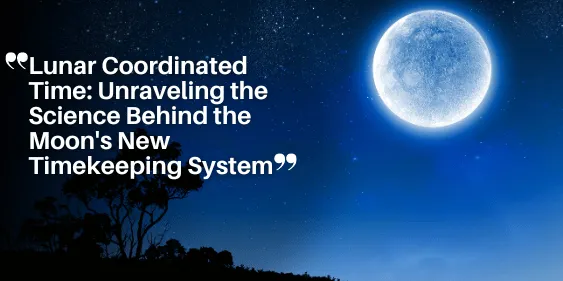Lunar Coordinated Time: Unraveling the Science Behind the Moon’s New Timekeeping System

Definition and Purpose of LTC
The Lunar Coordinated Time (LTC) initiative is an ambitious endeavor designed to alleviate the complications of timekeeping on the Moon.
LTC strives to establish a uniform system that aligns lunar activities and operations, enhancing our ability to conduct missions and research effectively.
With growing aspirations for lunar exploration, a reliable and consistent timekeeping standard is no longer a luxury but a necessity for seamless operations on both the Moon and Earth.
Need for a Dedicated Lunar Timekeeping System
One of the driving forces behind LTC is the necessity for a timekeeping system tailored to the Moon’s unique environment.
The Moon’s gravity is weaker than Earth’s, causing time to flow slightly faster—about 58.7 microseconds more per day.
While this difference might seem negligible, it can compound over time, leading to significant discrepancies that could jeopardize mission accuracy and safety.
These time differences can affect everything from navigation systems to the precise orchestration required for synchronized missions and scientific experiments.
Imagine a scenario where mission control schedules activities based on Earth time without accounting for the lunar time difference.
Even minor misalignments could result in missed communications or missteps during critical operations.
LTC ensures that mission planners and astronauts have a reliable reference, reducing the risk of errors and enhancing the mission’s overall success.
Importance of LTC for Future Lunar Missions
LTC’s importance is multifaceted, impacting various aspects of lunar missions. Standardized timekeeping is crucial for:
- Accurate navigation and positioning: Ensuring spacecraft are in the right place at the right time.
- Precise scientific experiments: Enabling accurate and repeatable measurements.
- Effective communication: Preventing time discrepancies from causing delays or misunderstandings.
- Mission safety: Reducing risks associated with timing errors, which could be catastrophic in the unforgiving environment of space.
As human activities on the Moon expand, a dedicated timekeeping system becomes increasingly indispensable.
LTC represents a foundational step towards a more organized and efficient lunar presence, paving the way for future missions, research initiatives, and possibly even lunar settlements.
By understanding and implementing LTC, we turn the Moon from a distant dream into a well-coordinated hub of human achievement and exploration.
The Science of Time Dilation on the Moon
The Time Dilation Effect on the Moon
Time dilation refers to the difference in the passage of time due to relative differences in gravity and velocity.
On the Moon, due to its weaker gravitational pull compared to Earth, time flows somewhat faster. Specifically, time on the Moon speeds up by about 58.7 microseconds every day.
While this may seem insignificant, it has profound implications for space missions extending over long durations.
Einstein’s Theory of Relativity
Albert Einstein’s theory of relativity lays the groundwork for understanding how gravity affects time.
According to the theory, the stronger the gravitational force, the slower time progresses.
Conversely, in weaker gravitational fields, such as that of the Moon, time moves slightly quicker.
This isn’t just a theoretical construct; it’s a measurable reality that scientists and engineers must account for in space exploration.
Quantifying the Time Difference
Let’s break down the numbers. On Earth, our atomic clocks measure time with extreme precision.
On the Moon, due to its weaker gravity, these same clocks would run faster by 58.7 microseconds each day.
Over a year, this trivial daily difference accumulates to over 21 milliseconds. For high-precision tasks like navigation and scientific experiments, this accumulating discrepancy cannot be ignored.
Understanding this time dilation effect on the Moon helps us appreciate the urgent need for a dedicated timekeeping system, like Lunar Coordinated Time (LTC), for all future lunar missions.
Implications of Time Discrepancy for Lunar Missions
Cumulative Effect of Time Difference Over Extended Lunar Stays
When we consider long-duration lunar missions, the time discrepancy between Earth and the Moon can no longer be ignored.
Because the Moon’s gravity is weaker, time there ticks by slightly faster—58.7 microseconds per day faster, to be precise.
While this might seem negligible at first glance, over extended stays, these microseconds add up.
Picture this: over the course of a year, the difference balloons to over 21 milliseconds.
This accumulation can affect synchronization with Earth-based systems, potentially complicating mission operations.
Impact on Critical Instruments Like Atomic Clocks
Accurate timekeeping is crucial in the high-stakes environment of space missions.
Atomic clocks, which are the backbone of precise time measurement, face significant challenges due to these time discrepancies.
These timepieces are essential for spacecraft navigation, timing scientific experiments, and maintaining communication links.
A 21-millisecond drift accumulated over a year could compromise the accuracy of these instruments, making it imperative to have a tailored lunar timekeeping system like LTC.
Potential Navigational Errors and Safety Concerns
Ignoring the lunar time discrepancy could cause navigational errors and jeopardize astronaut safety.
For instance, precise timing is essential for docking procedures, landing operations, and coordinating movements on the lunar surface.
Any deviation in timing, however small, can lead to miscalculations in position and velocity, posing serious risks to human life and the success of a mission.
Communication between Earth and lunar bases would also be impacted, leading to potential delays or misunderstandings during critical operations.
Given these challenges, developing and implementing Lunar Coordinated Time (LTC) represents a necessary step to ensure the precision and safety of future lunar missions.
This tailored timekeeping system will harmonize operations, minimizing risks and facilitating better synchronization between Earth and lunar activities.
Through international cooperation and technological innovation, LTC promises to be the backbone of seamless lunar exploration.
Technical Implementation of LTC
Challenges in Creating a Timekeeping System for Another Celestial Body
Creating a timekeeping system tailored for the Moon is a massive challenge.
Given the Moon’s unique environmental and gravitational differences from Earth, simply transferring Earth-based timekeeping methods isn’t feasible.
The primary hurdle is ensuring precise synchronization across various instruments and missions.
A consistent time standard must replace Earth-based systems which fail to account for the Moon’s time dilation — where time flows 58.7 microseconds faster daily. This difference, though minuscule daily, becomes significant over the long term.
Establishment of Synchronized Lunar Clock Network
A synchronized lunar clock network is at the heart of LTC.
This network involves an ensemble of high-precision atomic clocks placed at various lunar locations, including orbiters and surface installations.
These clocks will be interconnected, forming a robust system that accounts for local time variations due to the Moon’s topology and rotation.
- Atomic Clocks: High-precision atomic clocks are crucial because traditional mechanical clocks can’t deliver the required accuracy. By installing these clocks in significant lunar infrastructure, a common reference can be maintained.
- Inter-network Coordination: These clocks need continuous synchronization with one another to ensure time consistency across the Moon. This synchronicity immensely benefits navigation, communication, and conducting scientific experiments.
Development of Communication Protocols Accounting for Time Dilation
Implementing LTC demands sophisticated communication protocols to handle time dilation effectively. Given that time flows slightly faster on the Moon, communication systems need algorithms that adjust for this difference, ensuring accurate time information transmission between Earth and lunar bases.
- Dynamic Time Adjustment: Communication algorithms must dynamically adjust timestamps, correcting the 58.7 microseconds per day time dilation. This correction ensures that time-dependent operations such as landing sequences, data logging, and remote operation of lunar rovers remain accurate.
- Latency Management: To facilitate real-time operations on the Moon, managing communication latency is essential. Protocols should minimize delays introduced by the distance and time dilation between the Moon and Earth, thereby maintaining synchronization.
The precise establishment of these technical solutions lays a foundation for the smooth functioning of lunar missions.
It’s not just about creating time-keeping devices but ensuring every operation is harmonized seamlessly.
Next, we’ll explore the international cooperation and governance structures that are imperative to successfully implement LTC and ensure its global acceptance.
International Cooperation and Governance of LTC
The Need for a Central Governing Body
Developing and implementing Lunar Coordinated Time (LTC) is more than just a technical hurdle; it is a diplomatic initiative requiring substantial international cooperation.
Similar to Earth’s timekeeping standards overseen by organizations like the International Bureau of Weights and Measures (BIPM), LTC will necessitate a central governing body.
This authority will be crucial for synchronizing global lunar activities, ensuring that all missions, whether scientific, commercial, or governmental, adhere to a unified time standard.
Collaboration Between Space Agencies and Private Companies
LTC’s success hinges on collaboration. Space agencies such as NASA, ESA, Roscosmos, and others must work in tandem to establish this new timekeeping system.
Moreover, private companies venturing into lunar exploration, like SpaceX and Blue Origin, must also be participants.
This collaboration between public and private entities will help create a robust and inclusive lunar infrastructure.
Fostering a Unified Lunar Infrastructure
International collaboration extends beyond mere time synchronization.
A standardized lunar timekeeping system will foster a unified lunar infrastructure, making space exploration more efficient and safer.
Implementing LTC will reduce the risk of human error and streamline communication channels, ensuring smoother operations across various missions.
By embracing LTC, the global space community can pave the way for a more collaborative and prosperous future on the Moon.
Advancing LTC within the framework of international cooperation will not only solve technical and diplomatic challenges but also enhance the efficacy and safety of lunar missions.
Through a collaborative approach, we move closer to a future marked by precision and scientific discovery.






